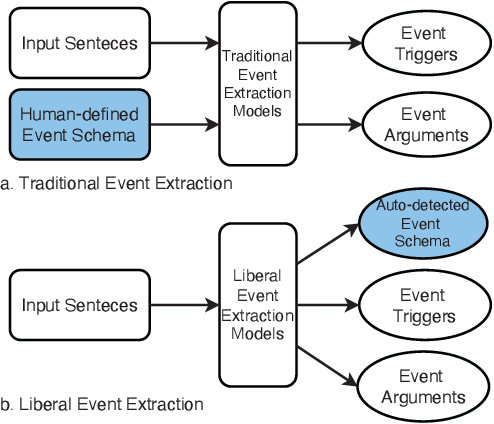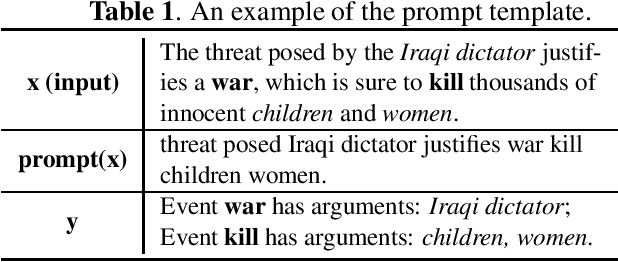Di Geng
Prompt-based Graph Model for Joint Liberal Event Extraction and Event Schema Induction
Mar 19, 2024



Abstract:Events are essential components of speech and texts, describing the changes in the state of entities. The event extraction task aims to identify and classify events and find their participants according to event schemas. Manually predefined event schemas have limited coverage and are hard to migrate across domains. Therefore, the researchers propose Liberal Event Extraction (LEE), which aims to extract events and discover event schemas simultaneously. However, existing LEE models rely heavily on external language knowledge bases and require the manual development of numerous rules for noise removal and knowledge alignment, which is complex and laborious. To this end, we propose a Prompt-based Graph Model for Liberal Event Extraction (PGLEE). Specifically, we use a prompt-based model to obtain candidate triggers and arguments, and then build heterogeneous event graphs to encode the structures within and between events. Experimental results prove that our approach achieves excellent performance with or without predefined event schemas, while the automatically detected event schemas are proven high quality.
GraphERE: Jointly Multiple Event-Event Relation Extraction via Graph-Enhanced Event Embeddings
Mar 19, 2024Abstract:Events describe the state changes of entities. In a document, multiple events are connected by various relations (e.g., Coreference, Temporal, Causal, and Subevent). Therefore, obtaining the connections between events through Event-Event Relation Extraction (ERE) is critical to understand natural language. There are two main problems in the current ERE works: a. Only embeddings of the event triggers are used for event feature representation, ignoring event arguments (e.g., time, place, person, etc.) and their structure within the event. b. The interconnection between relations (e.g., temporal and causal relations usually interact with each other ) is ignored. To solve the above problems, this paper proposes a jointly multiple ERE framework called GraphERE based on Graph-enhanced Event Embeddings. First, we enrich the event embeddings with event argument and structure features by using static AMR graphs and IE graphs; Then, to jointly extract multiple event relations, we use Node Transformer and construct Task-specific Dynamic Event Graphs for each type of relation. Finally, we used a multi-task learning strategy to train the whole framework. Experimental results on the latest MAVEN-ERE dataset validate that GraphERE significantly outperforms existing methods. Further analyses indicate the effectiveness of the graph-enhanced event embeddings and the joint extraction strategy.
 Add to Chrome
Add to Chrome Add to Firefox
Add to Firefox Add to Edge
Add to Edge